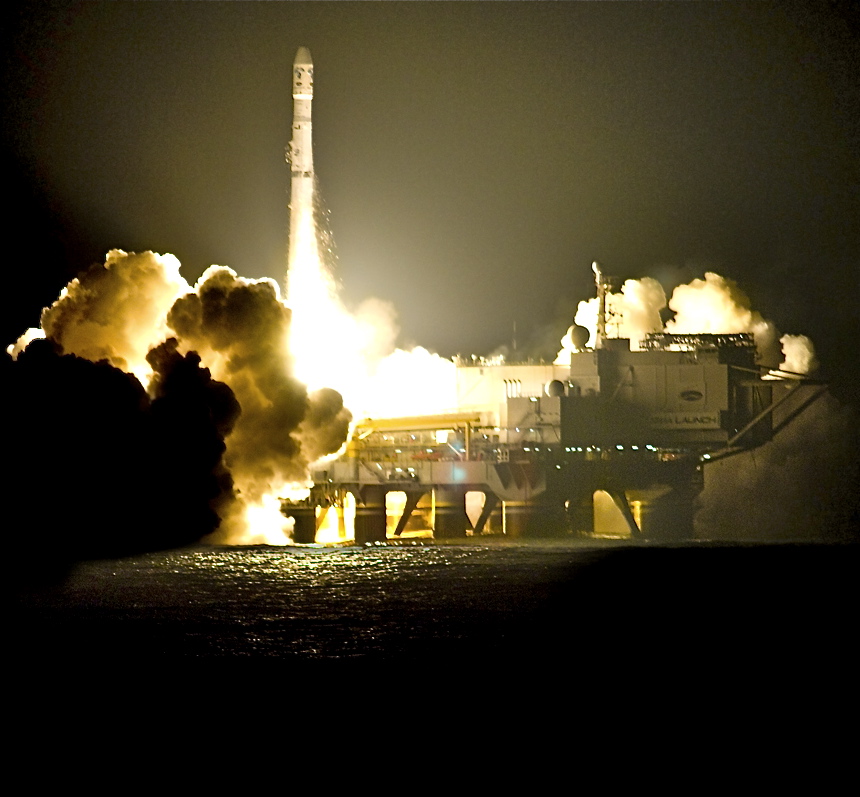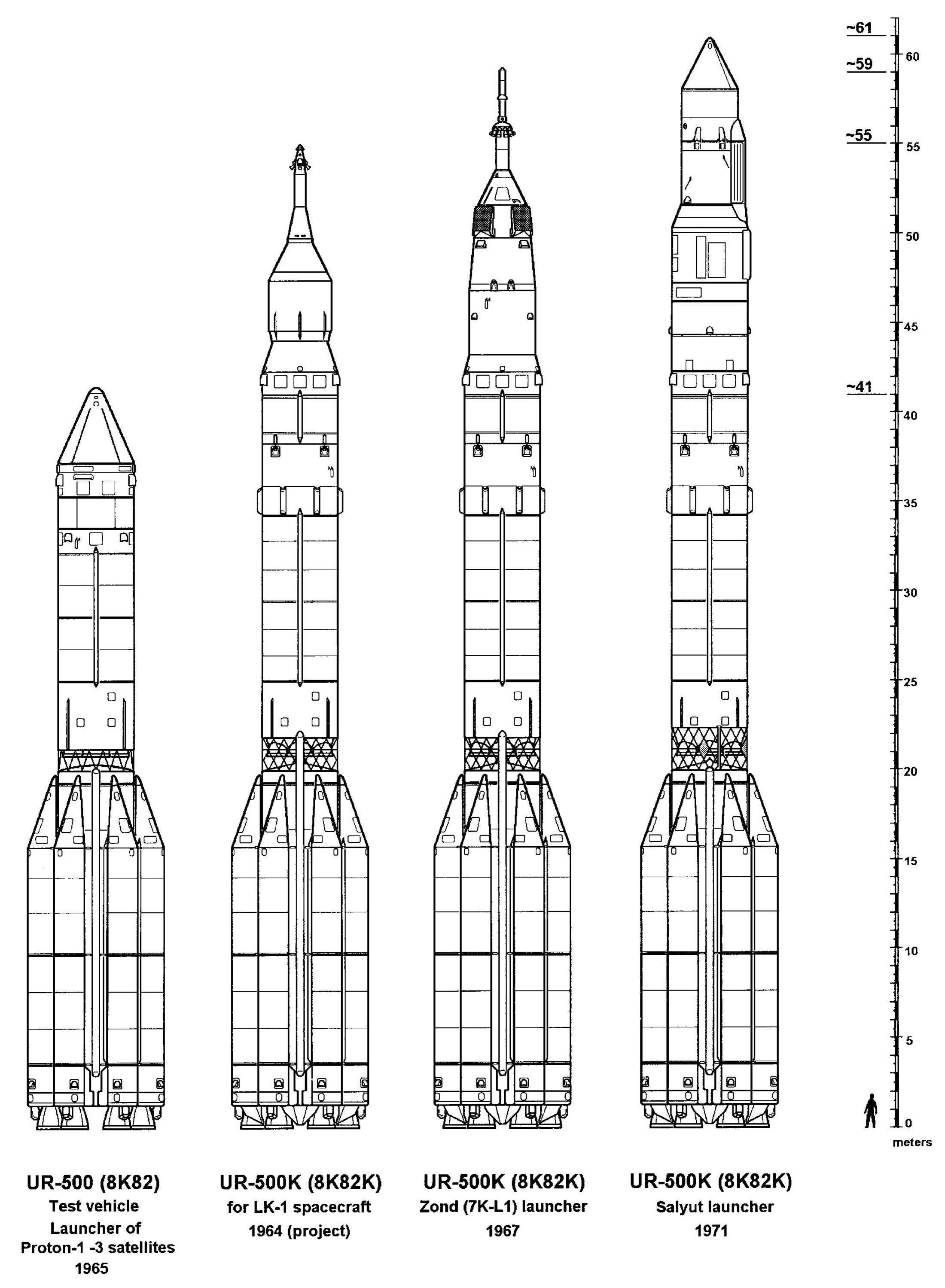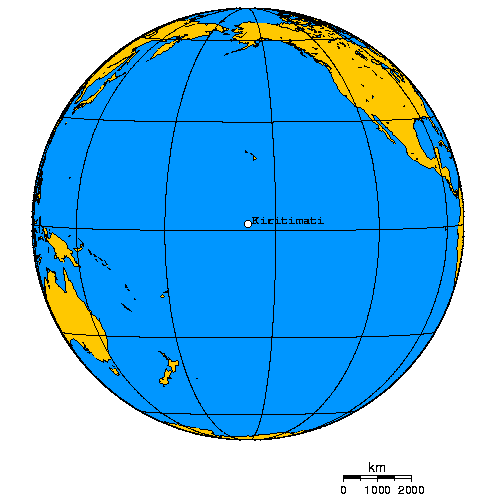|
Zenit 3SL
The Zenit-3SL is an expendable carrier rocket operated by Sea Launch. First flown in 1999, it has been launched 36 times, with three failures and one partial failure. It is a member of the Zenit family of rockets, and is built by the Yuzhnoye Design Bureau. RKK Energia produces the Block DM-SL upper stage, whilst the payload fairing is produced by Boeing. Launches are conducted from the Ocean Odyssey platform anchored on the equator in the Pacific Ocean, at a point with 154°W longitude, about 370 kilometres east of Kiritimati. The Zenit-3SL design began in the late 1980s as the Zenit-3, a proposed replacement for the Proton-K, which would have used a Zenit-2 rocket with a Block D upper stage. This proposal was shelved after the dissolution of the Soviet Union, as Russia inherited the space programme, however the Zenit was manufactured in Ukrainian SSR. Boeing became involved in the programme in 1994. The design was subsequently modified, with a modified version of the Block ... [...More Info...] [...Related Items...] OR: [Wikipedia] [Google] [Baidu] |
Zenit-3SL
The Zenit-3SL is an expendable carrier rocket operated by Sea Launch. First flown in 1999, it has been launched 36 times, with three failures and one partial failure. It is a member of the Zenit family of rockets, and is built by the Yuzhnoye Design Bureau. RKK Energia produces the Block DM-SL upper stage, whilst the payload fairing is produced by Boeing. Launches are conducted from the Ocean Odyssey platform anchored on the equator in the Pacific Ocean, at a point with 154°W longitude, about 370 kilometres east of Kiritimati. The Zenit-3SL design began in the late 1980s as the Zenit-3, a proposed replacement for the Proton-K, which would have used a Zenit-2 rocket with a Block D upper stage. This proposal was shelved after the dissolution of the Soviet Union, as Russia inherited the space programme, however the Zenit was manufactured in Ukrainian SSR. Boeing became involved in the programme in 1994. The design was subsequently modified, with a modified version of the B ... [...More Info...] [...Related Items...] OR: [Wikipedia] [Google] [Baidu] |
Sea Launch
Sea Launch was a multinational—Norway, Russia, Ukraine, United States—spacecraft launch company founded in 1995 that provided orbital launch services from 1999–2014. The company used a mobile maritime launch platform for equatorial launches of commercial payloads on specialized Zenit-3SL rockets from a former mobile/floating oil drilling rig renamed ''Odyssey''. By 2014, it had assembled and launched thirty-two rockets, with an additional three failures and one partial failure. All commercial payloads were communications satellites intended for geostationary transfer orbit with such customers as EchoStar, DirecTV, XM Satellite Radio, PanAmSat, and Thuraya. The approach Sea Launch LLC used was to assemble the launcher on a purpose-built ship '' Sea Launch Commander'' in Nimitz Rd., Long Beach, California, USA. The assembled spacecraft was then positioned on top of the self-propelled ''Odyssey'' floating launch platform and moved to the equatorial Pacific Ocean for lau ... [...More Info...] [...Related Items...] OR: [Wikipedia] [Google] [Baidu] |
Zenit (rocket Family)
Zenit ( uk, Зеніт, russian: Зени́т; meaning ''Zenith'') is a family of space launch vehicles designed by the Yuzhnoye Design Bureau in Dnipro, Ukraine, which was then part of the Soviet Union. Zenit was originally built in the 1980s for two purposes: as a liquid rocket booster for the Energia rocket and, equipped with a second stage, as a stand-alone middle-weight launcher with a payload greater than the 7 tonnes of the Soyuz but smaller than the 20 tonnes payload of the Proton. The last rocket family developed in the USSR, the Zenit was intended as an eventual replacement for the dated Soyuz and Proton families, and it would employ propellants which were safer and less toxic than the Proton's nitrogen tetroxide/UDMH mix. Zenit was planned to take over crewed spaceship launches from Soyuz, but these plans were abandoned after the dissolution of the Soviet Union in 1991. Zenit-3SL was launched by the Sea Launch consortium's floating launch platform in the Pacific Ocea ... [...More Info...] [...Related Items...] OR: [Wikipedia] [Google] [Baidu] |
RD-58M
The RD-58 (manufacturer designation 11D58) is a rocket engine, developed in the 1960s by OKB-1, now RKK Energia. The project was managed by Mikhail Melnikov, and it was based on the previous S1.5400 which was the first staged combustion engine in the world. The engine was initially created to power the Block D stage of the Soviet Union's abortive N-1 rocket. Derivatives of this stage are now used as upper stages on some Proton and Zenit rockets. An alternative version of the RD-58 chamber, featuring a shorter nozzle, was used as the N-1's roll-control engine. The RD-58 uses LOX as the oxidizer and RG-1 as fuel in an oxidizer rich staged combustion cycle. It features a single gimbaled chamber, radial centrifugal pumps with auxiliary booster pumps, and an oxygen-rich preburner. Recent modifications include a lightweight carbon-composite nozzle extender developed by NPO Iskra. The Buran spacecraft used two of an evolution of the RD-58M, called 17D12, as its main orbital correct ... [...More Info...] [...Related Items...] OR: [Wikipedia] [Google] [Baidu] |
Block D
Blok D (russian: Блок Д meaning Block D) is an upper stage used on Soviet and later Russian expendable launch systems, including the N1, Proton-K and Zenit. The stage (and its derivatives) has been included in more than 320 launched rockets . By 2002 its modification Blok DM had a 97% success rate in 218 flights since 1974, and 43 successful missions in 1997–2002. The stage was developed in 1960s as the fifth stage (' Д' is the fifth letter in the Cyrillic alphabet) for the Soviet Moonshot N1 rocket. The stage first flew in March 1967 while testing Zond of the moonshot program system. During manned lunar flight Blok D would be used for mid-course corrections on the flight to the Moon, then to place the lunar orbiter and lander into a lunar orbit, and decelerate moon-lander out onto its landing trajectory. Blok D was also included as fourth stage of Proton-K and as such flew on unmanned Soviet missions to Moon, Mars ( Mars 3) and Venus. It was used in the Proto ... [...More Info...] [...Related Items...] OR: [Wikipedia] [Google] [Baidu] |
Zenit-2
The Zenit-2 is a Ukrainian, previously Soviet, expendable carrier rocket. First flown in 1985, it has been launched 37 times, with 6 failures. It is a member of the Zenit family of rockets and was designed by the Yuzhmash. History With 13–15 ton payload in LEO, it was intended as up-middle-class launcher greater than 7-ton-payload middle Soyuz and smaller than 20-ton-payload heavy Proton. Zenit-2 would be certified for crewed launches and placed in specially built launch pad at Baykonur spaceport, carrying the new crewed partially reusable Zarya spacecraft that developed in end of the 1980s but was cancelled. Also in the 1980s Vladimir Chelomey's firm proposed the never realised 15-ton Uragan spaceplane, which would have been launched by Zenit-2. A modified version, the Zenit-2S, is used as the first two stages of the Sea Launch Zenit-3SL rocket. Launches of Zenit-2 rockets are conducted from Baikonur Cosmodrome Site 45/1. A second pad, 45/2, was also constructed, bu ... [...More Info...] [...Related Items...] OR: [Wikipedia] [Google] [Baidu] |
Proton-K
The Proton-K, also designated Proton 8K82K after its GRAU index or SL-12 after its model number, 8K82K, was a Russian, previously Soviet, carrier rocket derived from the earlier Proton. It was built by Khrunichev, and launched from sites 81 and 200 at the Baikonur Cosmodrome in Kazakhstan. The maiden flight on 10 March 1967 carried a Soyuz 7K-L1 as part of the Zond program. During the so-called Moon Race these Proton/Soyuz/Zond flights consisted of several uncrewed test flights of Soyuz spacecraft to highly elliptical or circumlunar orbits with the unrealized aim of landing Soviet cosmonauts on the Moon. It was retired from service in favour of the modernised Proton-M, making its 310th and final launch on 30 March 2012. Vehicle description The baseline Proton-K was a three-stage rocket. Thirty were launched in this configuration, with payloads including all of the Soviet Union's ''Salyut'' space stations, all Mir modules with the exception of the Docking Module, which ... [...More Info...] [...Related Items...] OR: [Wikipedia] [Google] [Baidu] |
Kiritimati
Kiritimati (also known as Christmas Island) is a Pacific Ocean atoll in the northern Line Islands. It is part of the Republic of Kiribati. The name is derived from the English word "Christmas" written in Gilbertese according to its phonology, in which the combination ''ti'' is pronounced ''s'', giving kiˈrɪsmæs. Kiritimati has the greatest land area of any atoll in the world, about ; its lagoon is roughly the same size. The atoll is about in perimeter, while the lagoon shoreline extends for over . Kiritimati comprises over 70% of the total land area of Kiribati, a country encompassing 33 Pacific atolls and islands. It lies north of the equator, south of Honolulu, and from San Francisco. Kiritimati is in the world's farthest forward time zone, UTC+14, and is therefore one of the first inhabited places on Earth to experience New Year's Day. (see also Caroline Atoll, Kiribati). Although it lies east of the 180th meridian, the Republic of Kiribati realigned the Inter ... [...More Info...] [...Related Items...] OR: [Wikipedia] [Google] [Baidu] |
Longitude
Longitude (, ) is a geographic coordinate that specifies the east– west position of a point on the surface of the Earth, or another celestial body. It is an angular measurement, usually expressed in degrees and denoted by the Greek letter lambda (λ). Meridians are semicircular lines running from pole to pole that connect points with the same longitude. The prime meridian defines 0° longitude; by convention the International Reference Meridian for the Earth passes near the Royal Observatory in Greenwich, England on the island of Great Britain. Positive longitudes are east of the prime meridian, and negative ones are west. Because of the Earth's rotation, there is a close connection between longitude and time measurement. Scientifically precise local time varies with longitude: a difference of 15° longitude corresponds to a one-hour difference in local time, due to the differing position in relation to the Sun. Comparing local time to an absolute measure of time a ... [...More Info...] [...Related Items...] OR: [Wikipedia] [Google] [Baidu] |
Pacific Ocean
The Pacific Ocean is the largest and deepest of Earth's five oceanic divisions. It extends from the Arctic Ocean in the north to the Southern Ocean (or, depending on definition, to Antarctica) in the south, and is bounded by the continents of Asia and Oceania in the west and the Americas in the east. At in area (as defined with a southern Antarctic border), this largest division of the World Ocean—and, in turn, the hydrosphere—covers about 46% of Earth's water surface and about 32% of its total surface area, larger than Earth's entire land area combined .Pacific Ocean . '' Britannica Concise.'' 2008: Encyclopædia Britannica, Inc. The centers of both the [...More Info...] [...Related Items...] OR: [Wikipedia] [Google] [Baidu] |
Equator
The equator is a circle of latitude, about in circumference, that divides Earth into the Northern and Southern hemispheres. It is an imaginary line located at 0 degrees latitude, halfway between the North and South poles. The term can also be used for any other celestial body that is roughly spherical. In spatial (3D) geometry, as applied in astronomy, the equator of a rotating spheroid (such as a planet) is the parallel (circle of latitude) at which latitude is defined to be 0°. It is an imaginary line on the spheroid, equidistant from its poles, dividing it into northern and southern hemispheres. In other words, it is the intersection of the spheroid with the plane perpendicular to its axis of rotation and midway between its geographical poles. On and near the equator (on Earth), noontime sunlight appears almost directly overhead (no more than about 23° from the zenith) every day, year-round. Consequently, the equator has a rather stable daytime temperature throu ... [...More Info...] [...Related Items...] OR: [Wikipedia] [Google] [Baidu] |
Payload Fairing
A payload fairing is a nose cone used to protect a spacecraft payload against the impact of dynamic pressure and aerodynamic heating during launch through an atmosphere. An additional function on some flights is to maintain the cleanroom environment for precision instruments. Once outside the atmosphere the fairing is jettisoned, exposing the payload to outer space. The standard payload fairing is typically a cone-cylinder combination, due to aerodynamic considerations, although other specialized fairings are in use. The type of fairing which separates into two halves upon jettisoning is called a clamshell fairing by way of analogy to the bifurcating shell of a clam. In some cases the fairing may enclose both the payload and the upper stage of the rocket, such as on Atlas V and Proton M. If the payload is attached both to the booster's core structures and to the fairing, the payload may still be affected by the fairing's bending loads, as well as inertia loads due to vibra ... [...More Info...] [...Related Items...] OR: [Wikipedia] [Google] [Baidu] |



.jpg)

